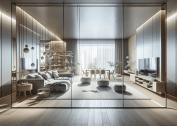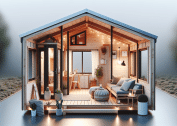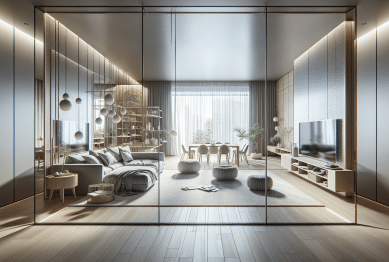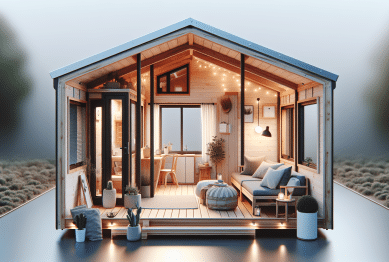Explore creative ways to personalize your living spaces with affordable home decor ideas. Learn how you can transform every room, maximize small budgets, and express your unique style while keeping comfort and functionality center stage.
Why Personalized Home Decor Matters
Personalized home decor goes far beyond simple aesthetics. It turns a dwelling into a reflection of personal journeys, creating meaningful connections to spaces where time is spent daily. Home environments are now viewed as a canvas for self-expression. Each object and arrangement tells a part of one’s story, so even minor details can make ordinary places feel like home. This personal touch improves emotional well-being and encourages positive routines. Keyphrase research reveals that people consistently search for budget-friendly ways to personalize, making it an important element in lifestyle and entertainment trends (Source: https://www.psychologytoday.com/us/blog/your-home/202110/the-hidden-benefits-personalizing-your-home).
Interestingly, design experts agree that custom touches add layers of comfort and enjoyment. When selecting items, consider family photos, artwork from local creators, and statement pieces that spark conversations. These accents do more than fill space—they foster happy memories and a sense of ownership. Furthermore, even small changes, like rearranging the furniture layout or introducing fresh colors, enliven rooms and change perceptions of space. Research links personalized settings to higher satisfaction and creativity levels, showing emotional benefits in everyday life (Source: https://www.ncbi.nlm.nih.gov/pmc/articles/PMC6025474/).
Creating a home that genuinely represents your personality can also positively impact relationships. If shared with family or friends, these spaces foster togetherness and make social visits more memorable. Warm, unique settings encourage guests to relax and feel included. Ultimately, a personalized living area becomes the backdrop for daily comfort and long-lasting connections, reinforcing the value of investing time in design decisions that are true to personal tastes and values.
Affordable Home Decor Ideas For Every Room
One of the biggest misconceptions about home design is that creating a beautiful, personalized space requires a substantial investment. Everyday items can be creatively repurposed for new functions or visual impact. For example, recycled glass jars offer both storage and visual charm in kitchens. Paint leftover from other projects adds accents to doors, picture frames, or even floors—small touches that dramatically freshen up a space. Integrating textures with throw blankets, pillows, or plants invites comfort without high costs. Websites and magazines regularly display realistic, tested DIY ideas for those who want to try something new without the risk (Source: https://www.houzz.com/magazine/budget-decorr).
Personalized wall art offers another affordable route. Downloadable prints, family-commissioned illustrations, or curated gallery walls blend individual stories with current decor trends. Even beginner artists can make abstract paintings for feature walls, while decorative calendars, world maps, or vision boards keep spaces lively and current. Textiles are another favorite among professionals; using curtains, rugs, and slipcovers to update style instantly while allowing frequent changes. These techniques use high-EPC keywords like affordable home decor and DIY wall art, which are sought by readers with an interest in practicality and aesthetics.
Multipurpose furniture extends affordability even further. Ottomans with storage, fold-down desks, and dual-purpose bookshelves efficiently use space and budget. Adjustable lighting, sourced from second-hand shops or discount retailers, adapts rooms for relaxation or productivity. Approaching decor as a series of mini-projects helps build momentum and confidence, resulting in evolving, unique spaces. For renters or those who move often, these touches can be adjusted without permanent installations or major remodeling costs.
Curating Your Unique Style At Home
Curating a personal style doesn’t require formal training or a background in interior design. It starts with identifying colors, materials, and patterns that consistently attract your attention in clothing, art, or travel. Developing mood boards online or collecting inspiration in a physical journal enables clear vision before committing time or money. Home style should blend inspiration with practicality—an approach favored by design professionals who recommend starting with small, confidence-building changes. Over time, these choices build a distinct signature visible in every room (Source: https://www.architecturaldigest.com/story/how-to-find-your-interior-design-style).
Texture and lighting play a significant role in shaping style. Natural materials such as wood, linen, and clay add warmth and authenticity. Incorporating family heirlooms or travel mementos blends personal history with current trends—a detail that appeals to those seeking homes with character. Experimenting with bold accent walls or statement lighting fixtures creates an immediate focal point. Don’t underestimate the effect of scent or sound: aromatic candles, oil diffusers, and carefully chosen playlists can instantly influence the atmosphere and emotional connection to a space.
Experts suggest rotating decor seasonally to keep the environment feeling fresh. Introducing new throw pillows, lightweight curtains, or spring-colored vases as the weather shifts subtly updates the home without overwhelming costs. This strategy allows decor to evolve alongside interests and routines, making it possible to enjoy current trends without permanent changes. Collecting inspiration, tracking what resonates, and experimenting boldly create a truly personalized space that grows with its inhabitants.
DIY Projects For Personalized Living Spaces
DIY home projects unlock creativity and empower people to make changes at their own pace. Beginners often start with simple crafts: hand-painted plant pots, unique coasters from leftover tile, or braided wall hangings from yarn or rope. As skills grow, more advanced ideas like furniture refurbishing or custom shelving become feasible. DIY not only saves money but also builds a deeper sense of pride and attachment to the finished space (Source: https://www.familyhandyman.com/list/budget-diy-home-decor-ideas/).
Online tutorials provide step-by-step instructions for a huge range of home decor projects. Upcycling old furniture, assembling decorative light fixtures, or creating macramé wall hangings lets anyone practice new skills and develop a unique style. In many cases, supplies are sourced from local discount shops or reclaimed from existing items at home, helping reduce environmental footprints. Engaging in these activities as a family or with friends can also turn projects into memorable bonding experiences, reinforcing the social benefits of DIY home decor.
For those looking for more advanced results, exploring woodworking or textile arts opens further avenues. Simple wooden frames, bookcases, or woven tapestries can be made over several weekends with the right guidance. These pieces last longer, hold significant sentimental value, and set homes apart from those filled with mass-produced items. Across skill levels, the emphasis should be on exploration and play—relieving perfectionist pressure and encouraging risk-taking in design.
Maximizing Small Spaces With Personalized Touches
Small apartments, studios, and shared spaces offer unique opportunities for creative, personalized decorating. Efficiency becomes essential: multifunctional furniture, vertical storage, and creative lighting achieve both utility and style. Strategies such as wall-mounted shelves, floating desks, and collapsible chairs give more room without appearing cluttered. Each square foot, when considered thoughtfully, presents a chance to showcase personal flair (Source: https://www.apartmenttherapy.com/10-ways-to-personalize-your-apartment-267262).
Mirrors and light colors visually expand tight quarters, while strategic use of bright accent pieces maintains energy and excitement. Incorporating plants—even small succulents or vertical herb gardens—improves air quality and creates fresh focal points. Removable decals and peel-and-stick wallpaper are favorites among renters and those who need non-permanent changes. Fold-away beds or nesting tables optimize daily living yet leave space available for guests or hobbies.
Personal organization also plays a major role in making small spaces functional and inviting. Accessories like labeled baskets, modular shelving, or under-bed storage ensure rooms remain tidy and efficient. By rotating decor with the seasons, rearranging flexible furniture, and continuously updating wall art, anyone can keep compact environments inspiring. Ultimately, these personalized touches transform small areas into vibrant, adaptable homes that truly represent those who live there.
Expressing Identity And Culture Through Decor
Decorating isn’t just about following trends—it’s about honoring identity, values, and cultural traditions. Tapestries, ceramics, and artworks from different backgrounds bring personal and collective histories into the home. Displaying handcrafted artifacts or family heirlooms showcases pride in heritage and invites conversations around traditions or memorable stories. These items not only look good but imbue homes with deep meaning valued by current lifestyle tastemakers (Source: https://www.smithsonianmag.com/arts-culture/the-benefits-of-personalizing-your-living-space-180974038/).
Crafting homemade items using traditional materials or techniques creates a unique bridge between past and present. Incorporating patterns, fabrics, or symbols passed down through generations visually tells a story with every glance. Photos, poetry, and music further elevate atmospheres, expressing passions and backgrounds to both visitors and daily occupants. Celebrating diversity in home surroundings encourages curiosity and acceptance, fostering multicultural understanding within households.
For those seeking inspiration, cultural decor trends and international design blogs offer innovative methods for mixing old and new. Adapting traditional motifs in a modern context respects roots while establishing a one-of-a-kind environment. These creative combinations are not limited by budget or size but guided by personal meaning—a crucial factor that helps homes remain authentic and welcoming as times and tastes change.
References
1. Whitbourne, S. (2021). The Hidden Benefits of Personalizing Your Home. Retrieved from https://www.psychologytoday.com/us/blog/your-home/202110/the-hidden-benefits-personalizing-your-home
2. Evans, G. W. (2018). The Built Environment and Mental Health. Retrieved from https://www.ncbi.nlm.nih.gov/pmc/articles/PMC6025474/
3. Houzz. (n.d.). 15 Ways to Decorate on a Budget. Retrieved from https://www.houzz.com/magazine/budget-decorr
4. Family Handyman. (n.d.). 40 Budget Home Decor Ideas That Only Look Expensive. Retrieved from https://www.familyhandyman.com/list/budget-diy-home-decor-ideas/
5. Apartment Therapy. (n.d.). 10 Ways to Personalize Your Apartment. Retrieved from https://www.apartmenttherapy.com/10-ways-to-personalize-your-apartment-267262
6. Smithsonian Magazine. (2019). The Benefits of Personalizing Your Living Space. Retrieved from https://www.smithsonianmag.com/arts-culture/the-benefits-of-personalizing-your-living-space-180974038/









